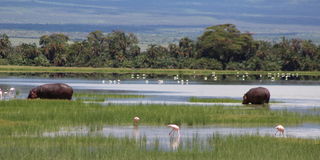The untold magic of Selenkay Conservancy

A pair of hipos foraging in swamp in Amboseli National Park. Copyright Denis Bouillon. One time use onky for Rupi Mangat. Photo | Pool
What you need to know:
- Dine and wine in luxury at the rustic canvas eco-camp in the natural glade of grassland, at the Porini Amboseli Camp
- It’s luxury in the wild – treat yourself. Your money goes into the Maasai children’s’ bursaries, health care and upkeep of the area
Kilimanjaro raises her beautiful snowy peak, revealing her full figure under a gorgeous blue sky. In one frame, Kibo the roof of Africa with her shorter siblings – Mawenzi and Shiro – shoulder her on either side.
In the early days of May, Kilimanjaro has us awed everyday – the clouds playing hide and seek with her.
Driving on the lush plains of her slopes, we’re at Selenkay that is so surreal that we could be in the biblical Garden of Eden with Africa’s magnificent wildlife – elephants, giraffes and gerenuks, Lesser kudus with their spiral horns, elands and wildebeest, impalas and the gazelles and raptors. When a young screeching tawny eagle on a tree is harassed by a pair of kamikaze-diving Black-shouldered kites, it’s pure drama in the wild.
Yet it’s hard to believe that until two decades ago, this land that’s now a Conservancy, was so bare that not an elephant could survive on it.

Elephant family grazing in Amboseli National Park. Copyright Denis Bouillon. One time use onky for Rupi Mangat Photo | Pool
Enjoying a refreshing gin and tonic on the raised platform near the waterhole after an exciting game drive, Michael the mighty tusker wanders in silently from the lush thickets, his tusks almost scrapping the ground. He takes us by surprise because we’ve been looking in the opposite direction at the mighty Kilimanjaro. On reaching the waterhole, he dips his trunk in the water, curls it and pours the water into his mouth. While we’re watching him, a whole herd of some 20 elephants of all ages and sizes materialise in the fading light to join Michael. There’s some rumbling going on with the big matriarch keeping an eye on her family while the teens playfully push each other aside to reach for the water.
The night blazes alive under the dark star-lit sky. Kilimanjaro has vanished but the night creatures awake. A serval is on the hunt, a mini leopard if you haven’t seen one. A little distance away, a pair of Bat-eared fox surface from the underground burrows, their large ears catching the sound of a potential prey. It’s Africa’s only fox.
It gets better when a pair of honey badgers turn up – black and white – foraging in the thick grass. I would do anything to watch them in action. Fearless though small, these mammals can fight off lions and kill cobras and other venomous snakes because they are immune to the deadly venom. With their strong paws, they raid the honey combs. In one of the most successful partnerships in nature, hunter-gatherers followed the honey guide that followed the honey badger to the hive. The honey gatherers even today leave a chunk of the waxy hive as a thank you to the honey badger.
The plan for the following day is to drive into Selenkay Conservancy’s more famous neighbour, the Amboseli National Park. One could not exist without the other for Selenkay is a vital migratory corridor for the elephants and other creatures between Amboseli, the Chyulu Hills, Tsavo and beyond.
It’s a mutual partnership between the park and the Conservancy, as Mzee Jake Grieves-Cook explains. He has been in the safari and wildlife business since the 1970s.
“I was concerned that as the protected area forming Amboseli National Park had been reduced in size, the wildlife dispersal areas including Selenkay which had previously been part of the larger Amboseli Reserve were going to be lost forever as a habitat for wild animals.”

Elephant family crossing road in Amboseli National Park. Copyright Denis Bouillon. One time use onky for Rupi Mangat Photo | Pool
Looking into the future, the veteran Mzee continues, “This is a semi-arid area and the local Maasai people had always practised a nomadic form of pastoralism in the past, moving their livestock seasonally to areas where there had been rain and where grazing was better. I felt that as the local people were now being forced to become more sedentary and settled, without being able to move their herds to other areas like their forefathers, they were going to suffer as there were few alternative income opportunities.”
It’s a play between healthy grasslands, wildlife and livestock.
“By keeping the livestock in one place year round there would be overgrazing and too much pressure on the environment,” continues Mzee. “So I thought that wildlife tourism could be a solution and that by setting up conservancies to expand the area of protected habitat beyond the parks and onto community lands this would create livelihoods and benefits for the people and would give the wildlife more space.”
It was the start of Selenkay Conservancy and of the rustic canvas eco-camp in the natural glade of grassland, Amboseli Porini Camp. As plain as it may seem, we dine and wine in luxury, looked after by our hosts, the local Maasai who are share-holders of the conservancy and the camp.
www.rupitheafricantrotter.com
Road to Selenkay
Check out Porini Amboseli Camp, 186 kms east of Nairobi, easy to reach on the new tarmac road from Kajiado.
You can drive there but private cars are not allowed for game drives.
Driving into Amboseli is optional.
It’s luxury in the wild – treat yourself. Your money goes into the Maasai children’s’ bursaries, health care and upkeep of the area.
Feedback to the editor: [email protected]




